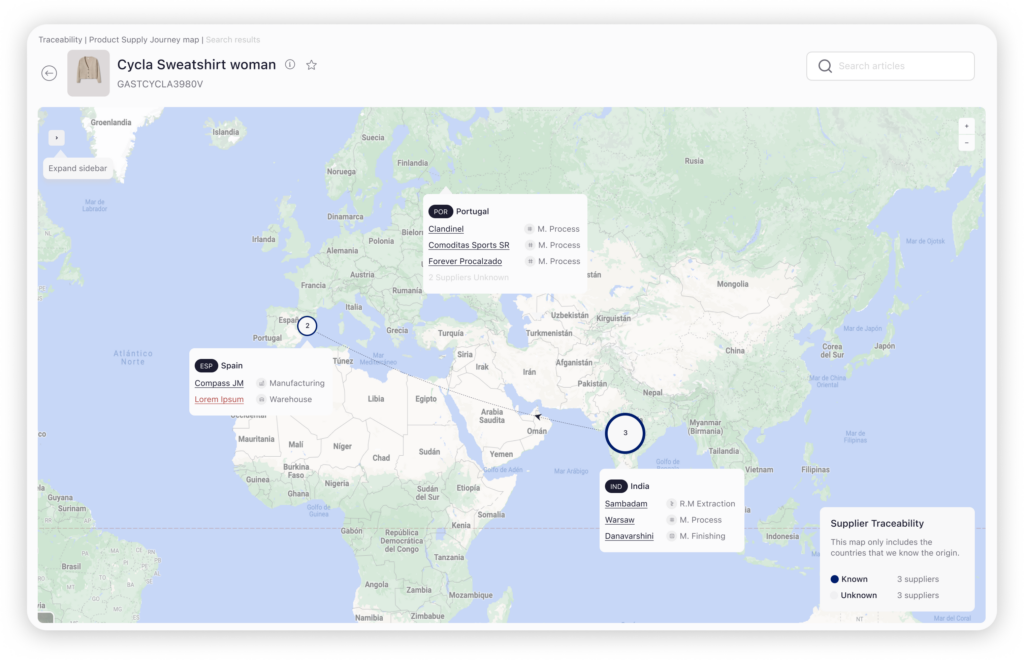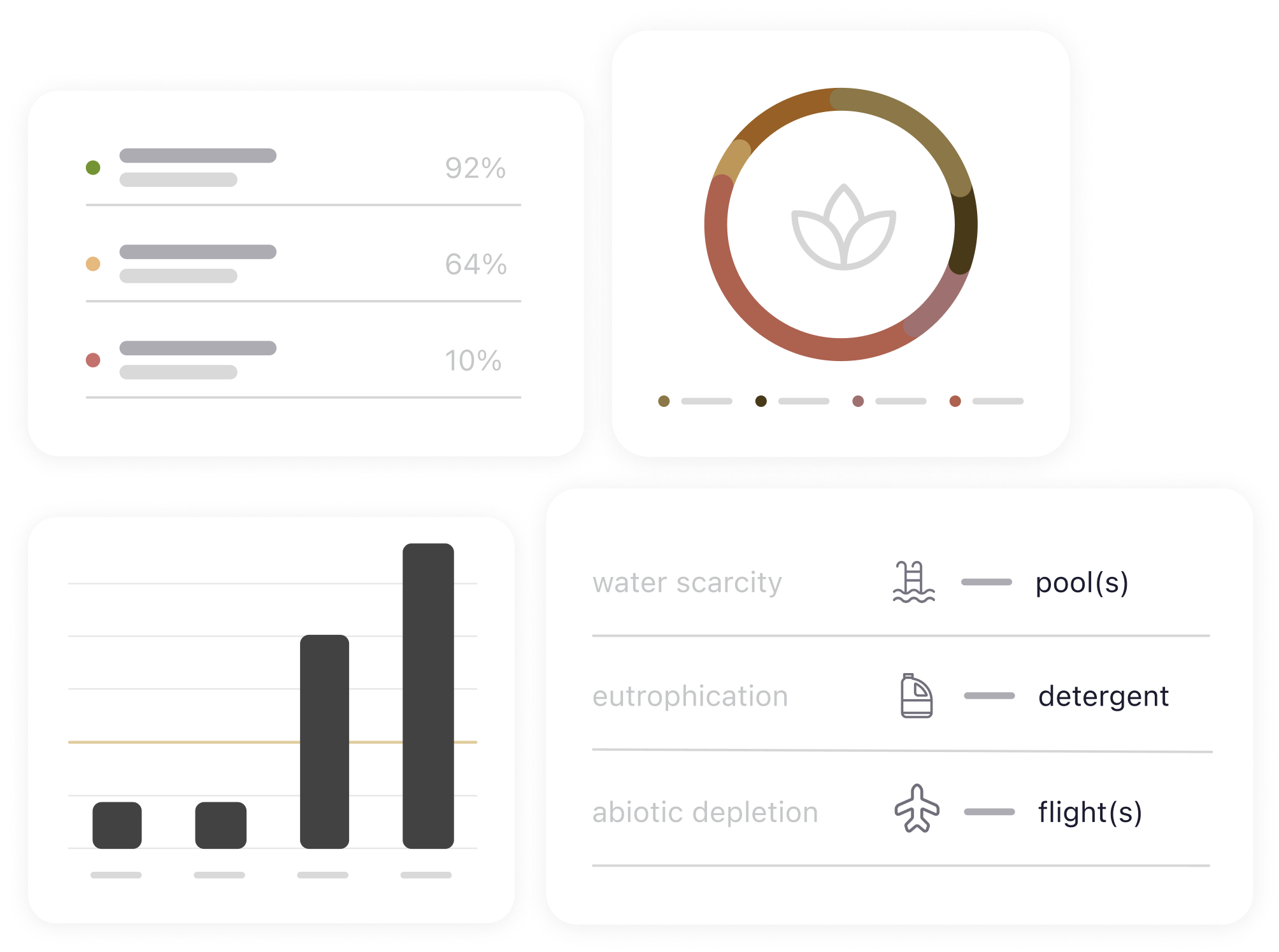A significant change in the fashion industry will only materialize if sustainability is integrated across all areas of the company. Over time, the belief that the responsibility for being more sustainable lies exclusively with the actions of the sustainability department has prevailed. However, those who have embraced sustainability as an essential element of their operations are truly the ones who have understood the potential of this approach. In this article, we will explore how to navigate the European Ecodesign for Sustainable Products Regulation from product and design teams to ensure the sustainability of your company from the conception of the product.
There is significant uncertainty prevailing within companies in the fashion industry regarding how to address this legislation clearly and efficiently
Considering that approximately 80% of a garment’s environmental impact is defined during the design phase, it is logical for ecodesign principles to guide the efforts of product and design departments. The European Union supports this notion, as evidenced by the March 2022 proposal for the new Ecodesign for Sustainable Products Regulation. This framework aims to set ecological design criteria for specific product categories, including textiles, with the goal of enhancing their circularity, energy efficiency, and other aspects related to environmental sustainability. Through this framework, a diverse range of requirements will be implemented, addressing aspects such as:
- Product durability, reusability, upgradability and reparability.
- Presence of substances that inhibit circularity.
- Energy and resource efficiency.
- Recycled content.
- Remanufacturing and recycling.
- Carbon and environmental footprints.
- Information requirements, including a Digital Product Passport.
This regulation is expected to be officially adopted in the spring of 2024, an imminent deadline that will position the fashion industry as a pioneer, being one of the first categories to comply with this standard.
However, despite the efforts of the European Union to enhance circularity in the textile sector, there is significant uncertainty prevailing within companies in the industry regarding how to address this legislation clearly and efficiently.
At BCome, we aim to provide clarity by offering you, once again, the essential solutions to meet the established requirements. Learn how, from the product and design team, you can take a proactive stance towards the European Ecodesign for Sustainable Products Regulation, ensuring that your items lead the market transformation.
Assess the impact of your decisions before making them
Imagine having a tool that allows you to compare the impact of different scenarios in your supply chain. From extraction to packaging, BCome provides you with the ability to analyze and compare two alternatives, enabling you to assess which one has a lesser impact. This way, you can make informed decisions based on data rather than relying on intuition.
With this tool, you can compare, in a few simple steps, the impact on water scarcity, CO2 emissions, eutrophication level, and fossil fuel consumption between one scenario and another.
Make a smart selection of your materials
Gaining this information establishes a crucial starting point for making a more informed selection of your fabrics, ensuring that they have the least possible impact. Given the wide variety of environmental indicators, a practical decision would be to compare similar fibers to each other. In other words, using Life Cycle Assessment to determine which type of material within a specific category to choose (for example, cotton), rather than attempting to select the most sustainable material among all options.
In this context, we present three key factors that will help you define the criteria that should influence your final choice of materials:
- Analyze the purpose of the garment. For example, if it is an activewear garment that will be frequently washed, and you want to offset water consumption, opting for a fabric with a reduced water footprint would be interesting.
- Define the characteristics that the fabric should have to achieve the best product performance. In the case of a summer garment requiring breathability, both cotton and organic cotton meet this property. However, choosing organic cotton entails a significant reduction in environmental impact compared to conventional cotton.
- Look for alternatives with similar performance to conventional fabrics. If you are in search of a lightweight, soft-touch fabric suitable for fresh and comfortable designs, instead of choosing viscose, which is often produced through intensive chemical processes, consider more sustainable alternatives like Tencel.
Understand in detail your supply chain
One of the major obstacles in reducing the environmental impact of products is the lack of transparency in the supply chain. Improving the traceability of your items will be crucial for achieving a more effective reduction of their impact, as you will have the necessary information to make informed decisions based on the reality of your chain.
- Locate your suppliers more efficiently. By analyzing the geographical distribution of your suppliers through a PLM system like the one provided by BCome, you can strategically select suppliers close to your manufacturing facilities or end markets. This is intended to reduce distances and the environmental impact associated with transportation.

- Select your suppliers based on their environmental performance. The PLM serves as a database that centralizes all details of your suppliers to better identify those who adhere to best practices and certifications.
- Identify the stages of the supply chain with the greatest impact. Through BCome’s platform LCA dashboard, you can analyze at a glance the allocation of environmental impact throughout the supply chain. This chart allows you to understand the weight of environmental indicators for each stage of the value chain, enabling you to take action in those stages with the greatest impact for each indicator.

Assess the environmental impact of your finished products
Developing sustainable products that follow the principles of ecodesign not only involves taking measures during the creation phase. A comprehensive evaluation of the impact of the finished product is essential to identify critical areas that can be improved in future collections.
Thanks to the metrics, data, and quality indicators derived from the Life Cycle Assessment provided by BCome, brands can draw conclusions and implement responsible solutions that significantly reduce their environmental impact. Below, we highlight some of the benefits that this analysis can bring to your business:
- Optimization of product development. Having specific indicators for each item in a collection allows the implementation of actions to reduce and eliminate the negative environmental impacts of these products at different stages of their life cycle.
- Improvement of efficiency in production processes and waste management. LCA facilitates the identification of high environmental risk points and the implementation of appropriate measures to mitigate them. Additionally, it enhances the efficiency of the supply chain by preventing an environmental problem from transferring to later stages.
- Anticipation of legislative requirements. Conducting a Life Cycle Assessment not only provides insights into the environmental impact of each product but also forms the basis for most regulations aligned with the Green Deal. Simply analyzing the impact of your items is not enough, compliance with legislation must be approached from a life cycle perspective.
Enhance circularity through key metrics
One key element of the Ecodesign for Sustainable Products Regulation is the focus on increasing the durability, reusability, upgradability, and repairability of products. In this regard, it is crucial for design and product departments to have specific metrics that enable them to ensure the extension of the products’ lifespan:
- Feedstock indicators. Measure the proportion of virgin materials in each product.
- End-of-life indicators. Provide information on the potential fate of an item once it becomes waste.
- Life cycle waste indicators. Represent the amount of waste that will ultimately end up in landfills or be incinerated.
- Usage potential indicators. Related to the duration and intensity of the use of items.
- Overview indicators. Provide a more detailed understanding of the product’s circularity.
The calculation of Circular Economy Indicators (CEI) by BCome is based on the Material Circularity Indicator (MCI) from the Ellen MacArthur Foundation. We streamline the measurement of circular performance for textile items through a process that ensures accuracy and reduces efforts on the part of the brand.
Become a valuable data provider for other departments
As mentioned at the beginning of the article, one of the novelties introduced by the Ecodesign for Sustainable Products Regulation is the implementation of the Digital Product Passport. This tool is designed to record, process and share information among supply chain companies, authorities and consumers.
The specific set of indicators that the Digital Product Passport must collect in the fashion industry is still in the process of definition. However, the regulation anticipates that products should comply with information requirements covering several aspects, such as durability and reliability, reuse, upgrading, repairability, maintenance and refurbishment possibilities, presence of concerning substances, energy use or energy efficiency, resource efficiency, recycled content, remanufacturing and recycling possibilities, material valorization potential, environmental impact, and projected waste generation.
Considering the currently established requirements, the early collection of this information by design and product teams would allow other departments to have the necessary data to feed the Digital Product Passport, a pivotal element in fulfilling the European Union’s sustainable transformation plan.
At BCome, we acknowledge the uncertainty surrounding the new European regulations. The Ecodesign for Sustainable Products Regulation is pivotal to the European Commission’s vision of promoting more circular and environmentally conscious products. Its imminent adoption involves collaboration with experts, and at BCome, we are equipped with the necessary tools to guide you confidently in this new regulatory landscape. Are you ready to take the next step towards sustainability? Let’s talk!









